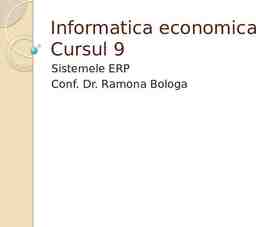ECON 1001 AB Introduction to Economics I Dr. Ka-fu WONG Sixth week of
31 Slides323.00 KB
ECON 1001 AB Introduction to Economics I Dr. Ka-fu WONG Sixth week of tutorial sessions KKL 925, K812, KKL 106 Clifford CHAN KKL 1109 [email protected]
Covered and to be covered Covered the week before the break Dr. Wong finished up to kf006.ppt You should have at least read up to Chapter 6 Perfectly competiti ve supply: The cost side of the market If not, please press hard on it. Start reading Chapter 7 To be covered in the tutorial sessions this week Problems in chapter 6: #1, #3, #5, #7 and #9 You are advised to work on the even ones as well
Problem #1, Chapter 6 (1) Zoe is trying to decide how to divide her time between he r job as a wedding photographer, which pays 27 per ho urs for as many hours as she chooses to work, and as a fossil collector, in which her pay depends both on the pri ce of fossils and the number of them she finds. Earnings aside, Zoe is indifferent between the two tasks, and the n umber of fossils she can find depends on the number of hours a day she researches, as shown in the table below .
Problem #1, Chapter 6 (2) Hours per day Total fossils per day 1 5 2 9 3 12 4 14 5 15
Solution to Problem #1 (1) Derive a table with a price in dollar increments from 0 to 30 in the first column and the quantity of fossils Zoe is willing to supply per day at that price in the second column
Solution to Problem #1 (2) In the first hour, Zoe can collect 5 fossils If the price of a fossil is 5, Zoe can make a total 25 in an hour if she devotes all her time to collecting fossils, which is less than the money she can earn from photography Thus, she won’t collect fossil if the price of a fossil is less than 5 If the price of a fossil is 6 Zoe should devote all her time to photography, as she can make 30 an hour from photography
Solution to Problem #1 (3) An additional hour would yield only 4 additional fossils or 24 additional revenue, so she should not spend any further time looking for fossils If the price of fossils rises to 7, however, the additional hour gathering fossils would yield an additional 28, so gathering fossils during that hour would then be the best choice, and Zoe would therefore supply 9 fossils per day
Solution to Problem #1 (4) Price of fossils ( ) # of fossils supplied / day 0–5 0 6 5 7, 8 9 9 – 13 12 14 – 26 14 27 15
Solution to Problem #1 (5) Plot these points in a graph with price on the vertical axis and quantity per day on the horizontal. What is this curve called? The curve will depict a price-quantity supplied relationship for fossils as follows In other words, it is SUPPLY CURVE for fossils
Solution to Problem #1 (6) Zoe's Supply Curve for Fossils Price ( /fossil) 35 30 25 20 15 10 5 0 0 5 10 Number of fossils 15 20
Problem #3, Chapter 6 (1) The Paducah Slugger Company makes baseball bats out of lumber supplied to it by Acme Sporting Goods, which pays Paducah 10 for each finished bat. Paducah’s only factors of production are lathe operators and a small building with a lathe. The number of bats per day it produces depends on the number of employee-hours per day, as shown in the table below.
Problem #3, Chapter 6 (2) # of bats per day # of employee-hours per day 0 0 5 1 10 2 15 4 20 7 25 11 30 16 35 22
Problem #3, Chapter 6 (3) If the wage is 15 per hour and Paducah’s daily fixed cost for the lathe and building is 60, what is the profitmaximizing quantity of bats? What would be the profit-maximizing number of bats if the firm’s fixed cost were not 60 per day but only 30?
Solution to Problem #3 (1) Quantity (bats/day) Total Revenue ( /day) Total labour cost (hours X wage) Total cost (labour cost fixed cost) Profit ( /day) (revenue – cost) 0 0 0 *15 0 0 60 60 - 60 5 50 1 *15 15 15 60 75 - 25 10 100 2 *15 30 30 60 90 10 15 150 4 *15 60 60 60 120 30 20 200 7 * 15 105 105 60 165 35 25 250 11 *15 165 165 60 225 25 30 300 16 *15 240 240 60 300 0 35 350 22 *15 330 330 60 390 - 40
Solution to Problem #3 (2) Based on the above table, we note that the profit-maximi zing quantity of bats is 20, as it yield the highest profit of 35 If the firm’s fixed cost decreases from 60 to 30, what is the profit maximizing quantity of bats? It is still 20 bats Why? Decrease in fixed cost will increase the profits across diff erent quantities of bats by the same amount ( 30) 20 bats will yield a new highest profit of 35 30 65
Problem #5, Chapter 6 The supply curve for the only two firms in a competitive industry are given by P 2Q1 and P 2 Q2, where Q1 is the output of firm 1 and Q2 is the output of firm 2. What is the market supply curve for this industry? (Hint: graph the two curves side by side, then add their respective quantities at a sample of different prices.)
Solution to Problem #5 (1) Horizontal summation means holding price fixed and adding the corresponding quantities Firm 1 P P 2Q1 6 Market supply curve Firm 2 P P 2 Q2 6 P S 6 P (4/3) (2/3)Q for P 2 4 4 4 2 2 2 1 2 3 Q1 2 4 Q2 P 2Q for P 2 1 4 Q 7
Problem #7, Chapter 6 For the pizza seller whose marginal, average variable, a nd average total cost curves are shown in the accompan ying diagram, what is the profit-maximizing level of outpu t and how much profit will this producer earn if the price of pizza is 2.50 per slice?
Solution to Problem #7 (1) Price ( /slice) MC 2.50 ATC AVC 1.40 0 570 Quantity (slices/day)
Solution to Problem #7 (2) Price ( /slice) MC ATC 2.50 AVC 1.40 0 570 Quantity (slices/day) Wrong! MC cuts ATC at its minimum.
Solution to Problem #7 (3) Price ( /slice) MC ATC 2.50 AVC 1.40 0 570 Quantity (slices/day) Wrong! MC cuts AVC at its minimum.
Solution to Problem #7 (4) Price ( /slice) MC ATC 2.50 AVC 1.40 0 570 Quantity (slices/day) Wrong! AVC and ATC approaches each other as quantity increases.
Solution to Problem #7 (5) Unless specific, assume it is a perfectly competitive market Firms are earning a zero economic profit Firms should always charge at a price that is equal to their marginal cost
Solution to Problem #7 (6) If P ATC AVC, the firm operates with a profit If ATC P AVC, the firm still operates but with a lossthe operation can cover part of its cost If ATC AVC P, the firm should shut down as it cannot even cover part of its cost
Solution to Problem #7 (7) To maximize profit, the firm will produce 570 slices of pizza a day Why? A perfectly competitive firm should always charge at a price that is equal to their marginal cost The associated profit is (P or MC – ATC)*Q ( 2.5 / slice - 1.4 / slice) * 570 slices / day 627 / day
Problem #9, Chapter 6 For the pizza seller whole marginal, average variable, and average total cost curves are shown in the accompanying diagram, what is the profit-maximizing level of output and how much profit will this producer earn if the price of pizza is 0.50 per slice?
Solution to Problem #9 (1) Price ( /slice) MC ATC AVC 1.18 0.68 0.50 0 260 Quantity (slices/day)
Solution to Problem #9 (2) Recall from Problem #7 If P ATC AVC, the firm operates with a profit If ATC P AVC, the firm still operates but with a loss- the operation can cover part of its cost If ATC AVC P, the firm should shut down as it cannot even cover part of its cost Based on the diagram above, where is the firm’s shut down point in the short run? The firm should shut down at a point where P 0.68 per slice (where P AVC) If a slice of pizza is sold for only 0.50, the firm will definitely not produce any pizza and shut down
Solution to Problem #9 (3) If the firm shuts down, there will be no (average) variable cost By shutting down the plant, the firm will have a negative profit that is exactly equal to the fixed cost Fixed cost Total cost – variable cost Total cost ATC * Q 1.18 / slice * 260 slices 306.80 / day Variable cost AVC * Q 0.68 / slice * 260 slices 176.80 / day
Solution to Problem #9 (4) Fixed cost 306.80/day - 176.80/day 130/day Thus, by shutting down the plant in the short run, the firm will loss 130 a day In other words, the firm earns a profit of - 130 per day if the price for a slice of pizza is just 0.50
The end Thanks for coming! See you next week!!!




































